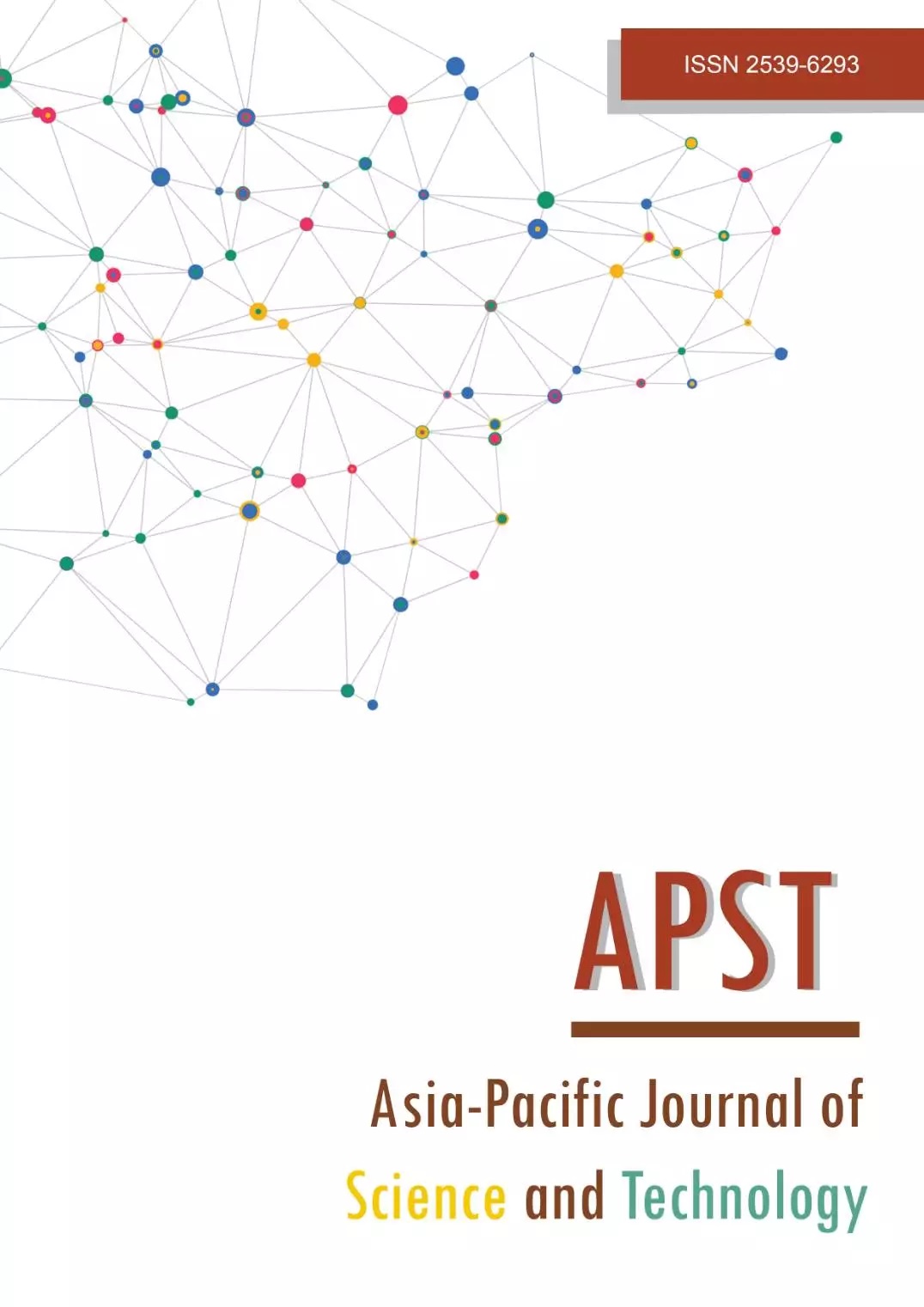Fusion of multimode near-infrared detections using multiblock data analysis for prediction of mixed sugar content
Main Article Content
Abstract
This study combined NIR spectral data from different detection modes to enhance the quantification performance of the instrument owing to the benefits of various detection modes in the near-infrared (NIR) spectroscopic technique. Mixed sugar samples, used for the demonstration, composed of glucose, fructose, maltose, and sucrose, were composed based on a mixture design. NIR spectra were recorded using portable Vis-NIR (360.9–1078.3 nm) and benchtop NIR (400–2500 nm) spectrometers using both transmittance and transflectance detection modes. A multiblock principal component analysis (MB-PCA) was applied to exploratorily analyze the multiblock data. Multiblock regression models, including concatenated partial least squares (C-PLS), serial-PLS (S-PLS), and multiblock-PLS (MB-PLS), were employed to quantify the sugar sample concentrations. MB-PCA could easily distinguish between the sugars, accounting for 98.51 % and 100.00 % for the portable Vis-NIR and benchtop NIR spectra on the first two principal components (PCs). The spectral fusion using the multiblock data analysis could improve the predictive performance. The best results were based on the use of MB-PLS, with values of R2 of 1.00, Q2 of 0.96, and 1.00; root mean square error of calibration (RMSEC) of 0.02 and 0.05; root mean square error of cross validation (RMSECV) of 0.22, and 0.06; ratio of prediction to deviation (RPD) of 5.03 and 18.43; and relative standard deviation (RSD) values of 5.63 and 1.54 using the portable Vis-NIR and benchtop NIR spectral data, respectively.
Article Details

This work is licensed under a Creative Commons Attribution-NonCommercial-NoDerivatives 4.0 International License.
References
Ozaki Y, Morisawa Y. Principles and characteristics of NIR spectroscopy. In: Ozaki Y, Huck C, Tsuchikawa S, Engelsen SB, editors. Near-Infrared Spectroscopy. Singapore: Springer; 2021. p. 11-35.
Agelet LE, Hurburgh CR. A tutorial on near infrared spectroscopy and its calibration. Crit Rev Anal Chem. 2010;40(4):246-260.
Alamprese C, Casale M, Sinelli N, Lanteri S, Casiraghi E. Detection of minced beef adulteration with turkey meat by UV-vis, NIR and MIR spectroscopy. LWT - Food Sci Technol. 2013;53(1):225-232.
Borràs E, Ferré J, Boqué R, Mestres M, Aceña L, Busto O. Data fusion methodologies for food and beverage authentication and quality assessment - A review. Anal Chim Acta. 2015;891:1-14.
Osborne BG. Near-infrared spectroscopy in food analysis. Encyclopedia of Analytical Chemistry. Chichester: John Wiley & Sons; 2006.
Pasquini C, Hespanhol MC, Cruz KAML, Pereira AF. Monitoring the quality of ethanol-based hand sanitizers by low-cost near-infrared spectroscopy. Microchem J. 2020;159:105421.
Pasquini C. Near infrared spectroscopy: fundamentals, practical aspects and analytical applications. J Braz Chem Soc. 2003;14(2):198-219.
Tao L, Via B, Wu Y, Xiao W, Liu X. NIR and MIR spectral data fusion for rapid detection of Lonicera japonica and Artemisia annua by liquid extraction process. Vib Spectrosc. 2019;102:31-38.
Smolinska A, Engel J, Szymanska E, Buydens L, Blanchet L. Chapter 3 - General framing of low-, mid-, and high-level data fusion with examples in the life sciences. In: Cocchi M, editor. Data Handling in Science and Technology, vol. 31. Amsterdam: Elsevier; 2019, p. 51-79.
Biancolillo A, Bucci R, Magrì AL, Magrì AD, Marini F. Data-fusion for multiplatform characterization of an italian craft beer aimed at its authentication. Anal Chim Acta. 2014;820:23-31.
Dai Y, Dai Z, Guo G, Wang B. Nondestructive identification of rice varieties by the data fusion of Raman and Near-Infrared (NIR) spectroscopies. Anal Lett. 2023;56(5):730-743.
Laxalde J, Caillol N, Wahl F, Ruckebusch C, Duponchel L. Combining near and mid infrared spectroscopy for heavy oil characterisation. Fuel 2014;133:310-316.
Brereton RG. Chemometrics: Data analysis for the laboratory and chemical plant. Chichester: John Wiley & Sons; 2003.
Westerhuis JA, Kourti T, MacGregor JF. Analysis of multiblock and hierarchical PCA and PLS models. J Chemom. 1998;12:301-321.
Hassani S, Hanafi M, Qannari EM, Kohler A. Deflation strategies for multi-block principal component analysis revisited. Chemometr Intell Lab Syst. 2013;120:154-168.
Qin SJ, Valle S, Piovoso MJ. On unifying multiblock analysis with application to decentralized process monitoring. J Chemom. 2001;15(9):715-742.
Felício CC, Brás LP, Lopes JA, Cabrita L, Menezes JC. Comparison of PLS algorithms in gasoline and gas oil parameter monitoring with MIR and NIR. Chemometr Intell Lab Syst. 2005;78(1-2):74-80.
Gaydou V, Kister J, Dupuy N. Evaluation of multiblock NIR/MIR PLS predictive models to detect adulteration of diesel/biodiesel blends by vegetal oil. Chemometr Intell Lab Syst. 2011;106(2):190-197.
Campos MP, Sousa R, Pereira AC, Reis MS. Advanced predictive methods for wine age prediction: Part II – A comparison study of multiblock regression approaches. Talanta 2017;171:132-142.
Wongsaipun S, Krongchai C, Jakmunee J, Kittiwachana S. Rice grain freshness measurement using rapid visco analyzer and chemometrics. Food Anal Methods. 2018;11:613-623.
Giangiacomo R. Study of water–sugar interactions at increasing sugar concentration by NIR spectroscopy. Food Chem. 2006;96(3):371-379.


